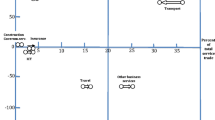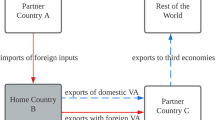Abstract
Global value chains are increasingly characterized by regional manufacturing “factories”: “factory” Europe, “factory” Asia, and “factory” North America. Underpinning these are the rules of origin (ROOs) of the regional trade agreements (RTAs). ROOs provide incentives to sourcing intermediate goods from the RTA parties, resulting in exclusionary effects on exports from third countries. The exclusionary effects are exacerbated in some ROOs because they are more restrictive than necessary to determine origin. Overall, product-specific ROOs in a plurilateral RTA that includes a manufacturing hub nation tend to be more restrictive than those in a bilateral RTA. Hence, the question arises whether the EU and Asia can develop an arrangement that can bridge the two regions without further fracturing global value chains. This chapter proposes that the extension of the Regional Convention on Pan-Euro-Med Preferential Rules of Origin (PEM Convention) to EU’s trading partners in Asia can enable geostrategic cooperation between the EU and its trading partners in Asia. In tandem with the underlying bilateral RTAs, the extended PEM Convention has an advantage over a plurilateral RTA because bilateral RTAs allow differentiated agreements in value-based issues. However, that the extension of the EU’s regional value chains to Asia may risk weakening global value chains.
Access this chapter
Tax calculation will be finalised at checkout
Purchases are for personal use only
Similar content being viewed by others
Notes
- 1.
Article I of the General Agreement on Tariffs and Trade (GATT) provides the MFN principle.
- 2.
Although the preferential elimination of tariffs under an RTA is in violation of GATT Article I, it is permitted under GATT Article XXIV as an exception to the GATT.
- 3.
This trade diversion effect occurs in addition to the trade diversion effect due to tariff elimination on final products.
- 4.
As the restrictive ROOs protect the industries within an RTA, the RTA parties would be less willing to conclude a new RTA with third countries. Thus, restrictive ROOs arguably pose obstacles to an RTA’s expansion of its membership.
- 5.
The parties to the RCEP are the ASEAN countries, China, Japan, Korea, Australia, and New Zealand.
- 6.
The parties to the CPTPP are Australia, Brunei, Canada, Chile, Japan, Malaysia, Mexico, New Zealand, Peru, Singapore, and Vietnam.
- 7.
The term RTA refers to both a free-trade area (FTA) and a customs union.
- 8.
Strict ROOs are employed to raise the cost in RTAs between developed and developing countries.
- 9.
The scope of the wholly obtained or produced could change depending on the definition of vessels, which may include any combination of registry, flag, and ownership of the vessels.
- 10.
The AFTA entered into force on 31 August 1977.
- 11.
The Agreement was signed by five founding members of the ASEAN and Brunei Darussalam on 28 January 1992 and came into force on the same date.
- 12.
In theory, non-discriminatory ROOs may be derived from some fundamental assumptions regarding wholly obtained and substantial transformation criteria. However, this approach would not bring fruitful results because countries do share common understanding about the wholly obtained and substantial transformation criteria.
- 13.
The PSRs for products under Chapter 2 under the KORUS FTA states: “A change to heading 02.01 through 02.10 from any other chapter, except from fowls of the species Gallus domesticus (chickens) of heading 01.05.”
- 14.
Crisscrossing RTAs is called spaghetti bowl of ROOs.
- 15.
The WTO Agreement on Rules of Origin is silent with regard to harmonization of preferential ROOs.
- 16.
See the preamble and paragraph 1 of Article 9 of the Agreement on Rules of Origin of the WTO Agreement.
- 17.
Empirical studies provide evidence that ROOs negatively affect sourcing of intermediate goods from third countries.
- 18.
The Free Trade Agreement between Canada and the United States of America (Canada-US FTA) was signed on 2 January 1988 and was phased out as NAFTA was enacted in January 1, 1994.
- 19.
The KORUS ROOs for ketchup (2103.20) states: “A change to subheading 2103.20 from any other chapter, provided that tomato ketchup of heading 2103.20 does not contain non-originating goods from subheading 2002.90.”
- 20.
The product-specific rule for ketchup in the Korea-EU FTA states: “Manufacture from materials of nay heading except that of the product. However, mustard flour or meal or prepared mustard may be used.”
- 21.
The committee has yet to decide on the rule.
- 22.
Under the PEM Convention, the PSRs for products under Chapter 84 except some states: “Manufacture in which the value of all the materials used does not exceed 30% of the ex-works price of the product.”
- 23.
Under the Korea-EU FTA, the PSRs for products under Chapter 84, except a few tariff lines, state: “Manufacture in which the value of all the materials used does not exceed 50% of the ex-works price of the product.”
- 24.
The RVC is calculated using the net cost method, which results in a more stringent requirement than the usual method based on transaction value.
- 25.
For ROOs for passenger vehicles (HS 8703.21 through 8703.90).
- 26.
Cross-cumulation can “only be applied if the Parties of final manufacture and of final destination have concluded free trade agreements, containing identical rules of origin, with all the Parties participating in the acquisition of originating status, i.e. with all the Parties from which the materials used originate. Materials originating in a Party which has not concluded an agreement with the Parties of final manufacture and/or of final destination shall be treated as non-originating.”
- 27.
If the cross-cumulation system were absent, the materials from the non-parties to the RTA would be deemed non-originating materials in the bilateral RTA between two countries that are parties to the convention.
- 28.
The EU initiated the PECS in 1997 between the EU members, the European Free Trade Association (EFTA) countries, the Central Eastern European Countries, and the Baltic States.
- 29.
In 2005, the system widened to participants to the Barcelona Process, resulting in the creation of the PEMCS based on bilateral protocols on ROOs.
References
Aggarwal, V. K., & Evenett, S. J. (2013). A fragmenting global economy: A weakened WTO, mega FTAs, and Murky protectionism. Swiss Political Science Review, 19(4), 550–557. https://doi.org/10.1111/spsr.12059.
Agreement on Rules of Origin. (1994, April 15). 1868 U.N.T.S. 397. https://www.wto.org/english/docs_e/legal_e/22-roo.pdf [hereinafter WTO Agreement on Rules of Origin].
The Agreement Between the EFTA States and Singapore. (2002, June 26). https://www.efta.int/free-trade/free-trade-agreements/singapore [hereinafter EFTA-Singapore FTA].
The Agreement Between the European Union and Japan for an Economic Partnership. (2018, July 17). https://www.mofa.go.jp/ecm/ie/page4e_000875.html [hereinafter EU-Japan EPA].
The Agreement on the Common Effective Preferential Tariff Scheme for the ASEAN Free Trade Area. (1992, January 28). https://asean.org/?static_post=agreement-on-the-common-effective-preferential-tariff-cept-scheme-for-the-asean-free-trade-area-afta [hereinafter CEPT-AFTA].
The ASEAN Trade in Goods Agreement. (2009, February 26). https://asean.org/asean-economic-community/asean-free-trade-area-afta-council/agreements-declarations/ [hereinafter ATIGA].
Augier, P., Gasiorek, M., & Tong, C. L. (2005). The impact of rules of origin on trade flows. Economic Policy, 20(43), 568–624. https://EconPapers.repec.org/RePEc:oup:ecpoli:v:20:y:2005:i:43:p:568-624.
Baldwin, R. E. (2013). Global supply chains: Why they emerged, why they matter, and where they are going. In D. K. Elms & P. Low (Eds.), Global value chains in a changing world (pp. 13–59). World Trade Organization. https://www.wto.org/english/res_e/booksp_e/aid4tradeglobalvalue13_e.pdf.
Barcelona Declaration. (1995). Euro-Mediterranean Conference. http://www.eeas.europa.eu/archives/docs/euromed/docs/bd_en.pdf.
Conconi, P., García-Santana, M., Puccio, L., & Venturini, R. (2018). From final goods to inputs: The protectionist effect of rules of origin. American Economic Review, 108(8), 2335–2365. https://doi.org/10.1257/aer.20161151.
Dziczek, K., Schultz, M., Swiecki, B., & Chen, Y. (2018, April). NAFTA briefing: Review of current NAFTA proposals and potential impacts on the North American automotive industry. Center for Automotive Research. https://www.cargroup.org/wp-content/uploads/2018/04/nafta_briefing_april_2018_public_version-final.pdf.
European Commission. (2005, October 12) Customs: Council approves new European-Mediterranean cumulation of origin zone. https://ec.europa.eu/commission/presscorner/detail/en/IP_05_1256.
European Commission. (2019). Commission notice concerning the application of the Regional Convention on pan-Euro-Mediterranean preferential rules of origin or the protocols on rules of origin providing for diagonal cumulation between the Contracting Parties to this Convention. Official Journal of the European Union, 2019/C 158/06. https://eur-lex.europa.eu/legal-content/EN/TXT/PDF/?uri=CELEX:52019XC0510(01)&from=EN.
Federal Department of Finance, the Swiss Confederation. (2019, May). Guide to the Pan-Euro-Mediterranean cumulation of origin. https://www.ezv.admin.ch/dam/ezv/en/dokumente/archiv/a5/ursprung/wegleitung_zur_pan-euro-mediterranenursprungskumulation.pdf.
The Free Trade Agreement Between the EFTA States and the Republic of Korea. (2005, December 15). https://www.efta.int/free-trade/free-trade-agreements/korea [hereinafter EFTA-Korea FTA].
The Free Trade Agreement Between the Government of the Republic of Korea and the Government of the Republic of Singapore. (2004, August 4). https://www.enterprisesg.gov.sg/non-financial-assistance/for-singapore-companies/free-trade-agreements/ftas/singapore-ftas/ksfta [hereinafter Korea-Singapore FTA].
General Agreement on Tariffs and Trade. (1977, November 1). Agreement on ASEAN preferential trading arrangements. World Trade Organization. https://docs.wto.org/gattdocs/q/GG/L4599/4581.pdf.
General Agreement on Tariffs and Trade. (1979, November 28). Differential and more favourable treatment reciprocity and fuller participation of developing countries. World Trade Organization. https://www.wto.org/english/docs_e/legal_e/enabling_e.pdf.
Global Affairs Canada. (n.d.). A new Canada-United States-Mexico Agreement. https://www.international.gc.ca/trade-commerce/trade-agreements-accords-commerciaux/agr-acc/cusma-aceum/index.aspx?lang=eng.
Hoekman, B., & Inama, S. (2018). Harmonization of rules of origin: An agenda for plurilateral cooperation. East Asian Economic Review, 22(1), 3–28. http://dx.doi.org/10.11644/KIEP.EAER.2018.22.1.336.
Kim, J. B., & Kim, J. (2011). The role of rules of origin to provide discipline to the GATT Article XXIV exception. Journal of International Economic Law, 14(3), 613–638. https://doi.org/10.1093/jiel/jgr027.
Kim, J. B. (2020). Cross-cumulation arrangement as FTA under GATT Article XXIV. Journal of International Economic Law, 23(1), 165–185. https://doi.org/10.1093/jiel/jgz027.
Manger, M. S. (2009). Investing in protection: The politics of preferential trade agreement between North and South. Cambridge University Press.
Mavroidis, P. C., & Vermulst, E. (2018). The case for dropping preferential rules of origin. Journal of World Trade, 52(1), 1–13.
Palmeter, D. (1996). Some inherent problems with free trade agreements. Law and Policy in International Business, 27(4), 991–998.
The Protocol Concerning the Definition of “Originating Products” and Methods of Administrative Cooperation, the Free Trade Agreement Between the European Union and its Member States, of the one part, and the Republic of Korea, of the other part. (2011, May 14). Official Journal of the European Communities, L127, 1344–1354. https://eur-lex.europa.eu/legal-content/EN/TXT/PDF/?uri=OJ:L:2011:127:FULL&from=EN [hereinafter Origin Protocol of the Korea-EU FTA].
Regional Convention on pan-Euro-Mediterranean preferential rules of origin (PEM Convention). (2013, February 26). Official Journal of the European Communities, L54, 4–158. https://eur-lex.europa.eu/legal-content/EN/TXT/PDF/?uri=OJ:L:2013:054:FULL&from=EN.
Reinsch, W. A., Caporal, J., Waddoups, M., & Tekarli, N. (2019, April 4). The impact of rules of origin on supply chains, USMCA’s auto rules as a case study. Center for Strategic and International Studies. https://csis-website-prod.s3.amazonaws.com/s3fs-public/publication/190403_Scholl_RulesofOrigin_WEB_v3.pdf.
Schott, J. J. (1997, July 22). The free trade area of the Americas: US interests and objectives. Peterson Institute for International Economics. https://www.piie.com/commentary/testimonies/free-trade-area-americas-us-interests-and-objectives.
World Customs Organization. (n.d.). Rules of origin, handbook. http://www.wcoomd.org/en/topics/origin/overview/origin-compendium.aspx.
The United States–Korea Free Trade Agreement (2007, June 30). https://ustr.gov/trade-agreements/free-trade-agreements/korus-fta/final-text [hereinafter KORUS FTA].
The United States–Mexico–Canada Agreement. (2018, November 30). Rules of origin—USMCA Chapter 4. https://usmca.com/rules-of-origin-usmca/.
U.S. Customs and Border Protection. (2014). Automotive products. https://www.cbp.gov/trade/nafta/guide-customs-procedures/provisions-specific-sectors/automotive-products.
World Trade Organization. (2002, June 20). Integrated negotiating text for the harmonization of work programme (G/RO/45/Add.8/Rev.3).
World Trade Organization. (2020, November 23). Report (2020) of the committee on rules of origin to the council for trade in goods (G/L/1378).
Acknowledgements
I would like to thank Ferdi De Ville, Johan Adriaensen, and Hans-Guenther Hilpert for helpful comments on the paper.
Author information
Authors and Affiliations
Corresponding author
Editor information
Editors and Affiliations
Rights and permissions
Copyright information
© 2022 The Author(s), under exclusive license to Springer Nature Switzerland AG
About this chapter
Cite this chapter
Kim, J.B. (2022). Rules of Origin: Bridging Regions to Withstand Turbulent Times. In: Adriaensen, J., Postnikov, E. (eds) A Geo-Economic Turn in Trade Policy?. The European Union in International Affairs. Palgrave Macmillan, Cham. https://doi.org/10.1007/978-3-030-81281-2_8
Download citation
DOI: https://doi.org/10.1007/978-3-030-81281-2_8
Published:
Publisher Name: Palgrave Macmillan, Cham
Print ISBN: 978-3-030-81280-5
Online ISBN: 978-3-030-81281-2
eBook Packages: Political Science and International StudiesPolitical Science and International Studies (R0)




